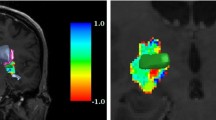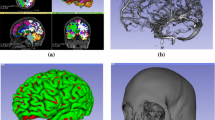Abstract
Purpose
The optimal electrode trajectory is needed to assist surgeons in planning Deep Brain Stimulation (DBS). A method for image-based trajectory planning was developed and tested.
Methods
Rules governing the DBS surgical procedure were defined with geometric constraints. A formal geometric solver using multimodal brain images and a template built from 15 brain MRI scans were used to identify a space of possible solutions and select the optimal one. For validation, a retrospective study of 30 DBS electrode implantations from 18 patients was performed. A trajectory was computed in each case and compared with the trajectories of the electrodes that were actually implanted.
Results
Computed trajectories had an average difference of 6.45° compared with reference trajectories and achieved a better overall score based on satisfaction of geometric constraints. Trajectories were computed in 2 min for each case.
Conclusion
A rule-based solver using pre-operative MR brain images can automatically compute relevant and accurate patient-specific DBS electrode trajectories.
Similar content being viewed by others
References
Adhami L, Coste-Manière E (2003) Optimal planning for minimally invasive surgical robots. IEEE Trans Rob Autom 19(5): 854–863
Altrogge I, Kröger T, Preusser T, Büskens C, Pereira P, Schmidt D, Weihusen A, Peitgen H (2006) Towards optimization of probe placement for radio-frequency ablation. In: Proceedings of MICCAI’06, Springer LNCS, vol 4190, pp 486–493
Baegert C, Essert-Villard C, Schreck P, Soler L, Gangi A (2007) Trajectory optimization for the planning of percutaneous radiofrequency ablation of hepatic tumors. Comput Aided Surg 12(2): 82–90
Baegert C, Villard C, Schreck P, Soler L (2007) Multi-criteria trajectory planning for hepatic radiofrequency ablation. In: Proceedings of MICCAI’07, Springer LNCS, vol 4791, pp 584–592
Baegert C, Villard C, Schreck P, Soler L (2007) Precise determination of regions of interest for hepatic RFA planning. In: Proceedings of medicine meets virtual reality (MMVR 15), vol 125. IOS Press, Amsterdam, pp 31–36
Benabid A, Chabardes S, Mitrofanis J, Pollak P (2009) Deep brain stimulation of the subthalamic nucleus for the treatment of parkinson’s disease. The Lancet Neurol 8(1): 67–81
Benabid A, Pollak P, Gross C, Hoffmann D, Benazzouz A, Gao D, Laurent A, Gentil M, Perret J (1994) Acute and long-term effects of subthalamic nucleus stimulation in parkinson’s disease. Stereotact Funct Neurosurg 62: 76–84
Bergman H, Wichmann T, DeLong M (1990) Reversal of experimental parkinsonism by lesions of the subthalamic nucleus. Science 249(4975): 1436–1438
Botsch M, Kobbelt L (2004) A remeshing approach to multiresolution modeling. In: Proceedings of the 2004 Eurographics/ACM SIGGRAPH symposium on geometry processing, pp 185–192
Bourbakis N, Awad M (2003) A 3-D visualization method for image-guided brain surgery. IEEE Trans Syst Man Cybern Part B Cybern 33(5): 766–781
Brunenberg E, Vilanova A, Visser-Vandewalle V, Temel Y, Ackermans L, Platel B, ter Haar Romeny B (2007) Automatic trajectory planning for deep brain stimulation: a feasibility study. In: Proceedings of MICCAI’07, Springer LNCS, vol 4791, pp 584–592
Chaturvedi A, Butson CR, Lempka SF, Cooper SE, McIntyre CC (2010) Patient-specific models of deep brain stimulation: influence of field model complexity on neural activation predictions. Brain Stimul 3(2): 65–77
Cointepas Y, Mangin J, Garnero L, Poline J, Benali H (2001) BrainVISA: software platform for visualization and analysis of multi-modality brain data. NeuroImage 13(6):98–98. http://brainvisa.info/
Coupé P, Yger P, Prima S, Hellier P, Kervrann C, Barillot C (2008) An optimized blockwise nonlocal means denoising filter for 3-D magnetic resonance images. IEEE Trans Med Imaging 27(4): 425–441
D’Haese PF, Cetinkaya E, Konrad PE, Kao C, Dawant BM (2005) Computer-aided placement of deep brain stimulators: from planning to intraoperative guidance. IEEE Trans Med Imaging 24(11): 1469–1478
Essert C, Haegelen C, Jannin P (2010) Automatic computation of electrodes trajectory for deep brain stimulation. In: Proceedings of MICCAI workshop in Medical Imaging and Augmented Reality, MICCAI MIAR’10, pp 149–158
Fujii T, Emoto H, Sugou N, Mito T, Shibata I (2003) Neuropath planner-automatic path searching for neurosurgery. In: Proceedings of CARS’03, vol 1256, pp 587–596. Elsevier, Germany
Guo T, Parrent A, Peters T (2007) Automatic target and trajectory identification for deep brain stimulation (DBS) procedures. In: Proceedings of MICCAI’07, Springer LNCS, vol 4791, pp 483–490
Hellier P, Barillot C (2003) Coupling dense and landmark-based approaches for nonrigid registration. IEEE Trans Med Imaging 22(2): 217–227
Koller W, Pahwa R, Lyons K, Wilkinson S (2000) Deep brain stimulation of the Vim nucleus of the thalamus for the treatment of tremor. Neurology 55(12): S29–S33
Lalys F, Haegelen C, Ferre J, El-Ganaoui O, Jannin P (2010) Construction and assessment of a 3-T MRI brain template. NeuroImage 49(1): 345–354
Le Goualher G, Barillot C, Bizais Y (1997) Modeling cortical sulci with active ribbons. Int J Pattern Recognit Artif Intell 11(8): 1295–1315
Lee J, Huang C, Lee S (2002) Improving stereotactic surgery using 3-D reconstruction. IEEE Eng Med Biol Mag 21(6): 109–116
Lezcano E, Gmez-Esteban JC, Zarranz JJ, Lambarri I, Madoz P, Bilbao G, Pomposo I, Garibi J (2004) Improvement in quality of life in patients with advanced parkinson’s disease following bilateral deep-brain stimulation in subthalamic nucleus. Eur J Neurol 11(7): 451–454
Limousin P, Krack P, Pollak P, Benazzouz A, Ardouin C, Hoffmann D, Benabid AL (1998) Electrical stimulation of the subthalamic nucleus in advanced parkinson’s disease. New Engl J Med 339(16): 1105–1111
Lorensen WE, Cline HE (1987) Marching cubes: a high resolution 3D surface construction algorithm. SIGGRAPH Comput Graph 21(4): 163–169
Maleike D, Nolden M, Meinzer H, Wolf I (2009) Interactive segmentation framework of the medical imaging interaction toolkit. Computer methods and programs in biomedicine 96(1):72–83. http://www.mitk.org
Mangin J (2000) Entropy minimization for automatic correction of intensity nonuniformity. In: Proceedings of IEEE workshop on mathematical methods in biomedical image analysis, pp 162–169
Mangin J, Coulon O, Frouin V (1998) Robust brain segmentation using histogram scale-space analysis and mathematical morphology. In: Proceedings of MICCAI98, vol 1496, pp 1230–1241
Nowinski W, Yang G, Yeo T (2002) Computer-aided stereotactic functional neurosurgery enhanced by the use of the multiple brain atlas database. IEEE Trans Med Imaging 19(1): 62–69
Schumann C, Bieberstein J, Trumm C, Schmidt D, Bruners P, Niethammer M, Hoffmann R, Mahnken A, Pereira P, Peitgen H (2010) Fast automatic path proposal computation for hepatic needle placement. In: Proceedings of SPIE medical imaging: visualization, image-guided procedures, and modeling, vol 7625, p 76251J
Seitel A, Engel M, Sommer C, Redeleff B, Essert C, Baegert C, Fangerau M, Fritzsche K, Yung K, Meinzer HP, Maier-Hein L (2011) Computer-assisted trajectory planning for percutaneous needle insertions. Med Phys 38(6): 3246–3260
Shamir R, Tamir I, Dabool E, Joskowicz L, Shoshan Y (2010) A method for planning safe trajectories in image-guided keyhole neurosurgery. In: Proceedings of MICCAI’10, Springer LNCS, vol 6363, pp 457–464
Starr P, Turner R, Rau G, Lindsey N, Heath S, Volz M, Ostrem J, Marks W Jr (2006) Microelectrode-guided implantation of deep brain stimulators into the globus pallidus internus for dystonia: techniques, electrode locations, and outcomes. J Neurosurg 104(4): 488–501
Vaillant M, Davatzikos C, Taylor R, Bryan R (1997) A path-planning algorithm for image-guided neurosurgery. In: Proceedings of CVRMed-MRCAS’97, Springer LNCS, vol 1205, pp 467–476
Villard C, Soler L, Papier N, Agnus V, Gangi A, Mutter D, Marescaux J (2003) RF-Sim: a treatment planning tool for radiofrequency ablation of hepatic tumors. In: Proceedings of information visualization. IEEE Computer Society Press, Los Alamitos, pp 561–566
Wiest-Daesslé N, Yger P, Prima S, Barillot C (2007) Evaluation of a new optimisation algorithm for rigid registration of MRI data. In: Proceedings of SPIE medical imaging, vol 6512, p 651206
Winkler D, Tittgemeyer M, Schwarz J, Preul C, Strecker K, Meixensberger J (2005) The first evaluation of brain shift during functional neurosurgery by deformation field analysis. J Neurol Neurosurg Psychiatr 76(8): 1161–1163
Wolf I, Vetter M, Wegner I, Bttger T, Nolden M, Schbinger M, Hastenteufel M, Kunert T, Meinzer HP (2005) The Medical imaging interaction toolkit. Med Image Anal 9(6):594–604. http://www.mitk.org
York MK, Wilde EA, Simpson R, Jankovic J (2009) Relationship between neuropsychological outcome and DBS surgical trajectory and electrode location. J Neurol Sci 287(1-2): 159–171
Author information
Authors and Affiliations
Corresponding author
Rights and permissions
About this article
Cite this article
Essert, C., Haegelen, C., Lalys, F. et al. Automatic computation of electrode trajectories for Deep Brain Stimulation: a hybrid symbolic and numerical approach. Int J CARS 7, 517–532 (2012). https://doi.org/10.1007/s11548-011-0651-8
Received:
Accepted:
Published:
Issue Date:
DOI: https://doi.org/10.1007/s11548-011-0651-8




